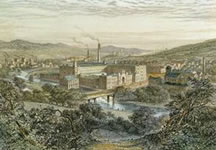|
About Alpacas>History |
Native to the South American altiplano (mainly in Chile, Peru, and Bolivia), alpacas were first domesticated about 5000 years ago in what came to be known as Peru. By the time of the Spanish conquest in the 16th century there were many millions of alpacas which had been highly bred for their fine fleece. Mummified remains show fleeces of a quality still a dream in current times. The Spanish invasion marked the end of these bloodlines. The villages of the altiplano were routed and the herds decimated or used for food as the Spanish cleared the available land for use by their own import: sheep.
Only in the last two centuries have alpaca herds been re-established in the Andes, and attempts to breed selectively for quality are few and much more recent. |
|
|
|
 |
| Alpacas in the altiplano |
|
|
| |
| Alpacas made their debut in European zoos in the middle of the 19th century, and the Victorians made much of their beautiful and fine fleece. |
 |
| Saltair |
|
|
|
The animals bred easily and zoo populations grew well but it wasn’t until the late 1980s that a few individuals in Britain approached the zoos and were allowed to buy surplus alpacas heralding the beginning of Britain’s breeding industry. Australia and the USA had already imported alpacas from Chile some years before and in the mid 1990s breeders here started to import better quality alpacas from Chile themselves. In the late 1990s the Peruvians relaxed their rules governing exports and a sea change in quality found its way to Britain. This situation led to the stylised reference to ‘Chilean’ alpacas (meaning representative of the poorer quality existing before the Peruvian imports) and ‘Peruvian’ (meaning descended from the ‘higher’ bloodlines of the Peruvian exports). These terms are more-or-less redundant today as the British, Australian, and USA breeders define their own bloodlines.
|
|
The global population of alpacas is on the increase as breeders outside South America see the business opportunities available (see Advice for Beginners). There are around 3 million in South America, 60,000 in North America, 80,000 in Australasia, and about 20,000 in Europe 15,000 of which are in the UK. Ninety-five percent of the worldwide alpaca population are white.
|
|
|